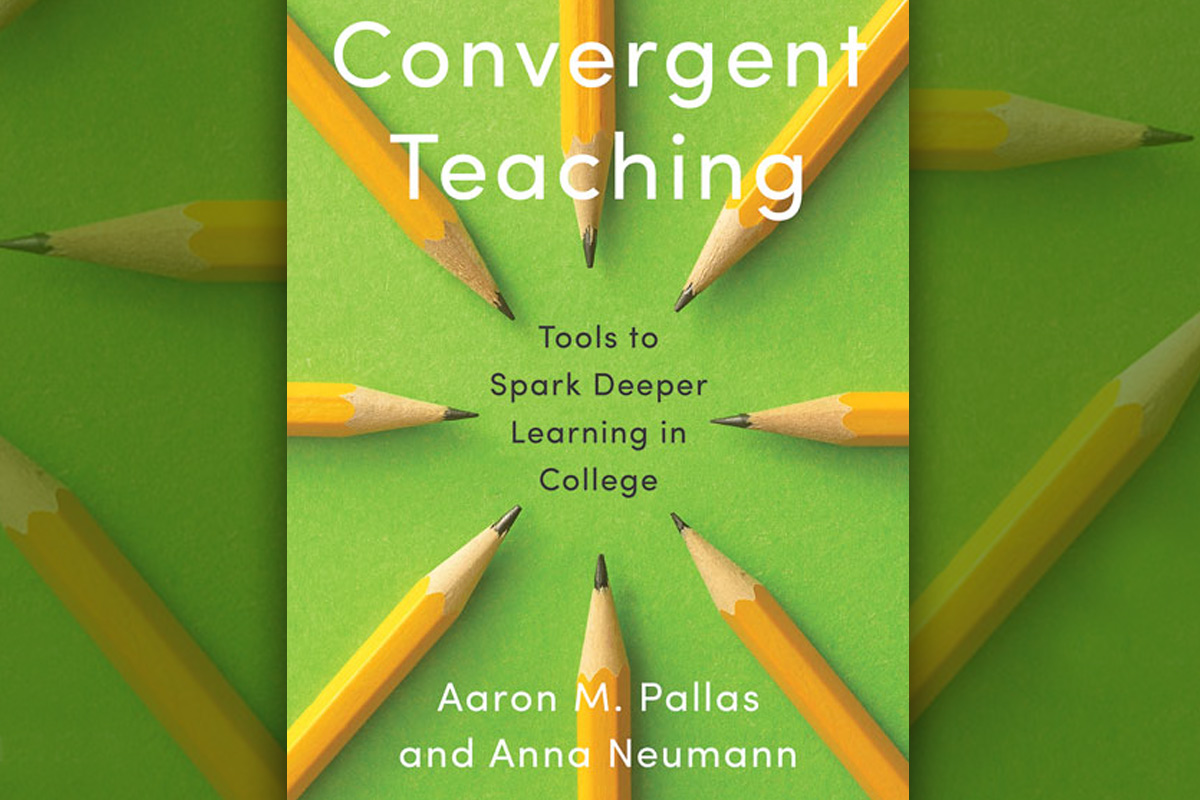Chris Felton is a new junior faculty member in political science at a small private college in the Midwest. Tasked with teaching introductory American politics, he’s smart, caring, hardworking – and completely at sea:
“Chris had no formal preparation for college-level teaching…the department didn’t discuss teaching in its monthly faculty meetings, and what his colleagues hoped that students would learn in the introductory courses or even as undergraduate majors was never addressed publicly…his prospects for promotion and tenure would be judged primarily on the basis of his research productivity. There were no incentives to be a great teacher – only incentives not to be an awful one.”

Anna Neumann, Professor of Higher Education (Photo: TC Archives)
“Chris Felton” is a fictitious character, but as Aaron Pallas and Anna Neumann make clear in their new book, Convergent Teaching: Tools to Spark Deeper Learning in College (Johns Hopkins University Press 2019), he is an all-too pervasive reality at colleges and universities across the nation.
“There’s a lot that can be done to improve higher education, but most reform initiatives do not aim at the center of the target: college teaching and student learning,” write Pallas, TC’s Arthur I. Gates Professor of Sociology & Education, and Neumann, Professor of Higher Education. “Going to college is the engine of the American dream, but there is much more attention to the acquisition of credentials that can be exchanged for jobs and a comfortable standard of living than to the learning of anything in particular.”
There’s a lot that can be done to improve higher education, but most reform initiatives do not aim at the center of the target: college teaching and student learning.
—Aaron Pallas and Anna Neumann
The solution to this crisis, as framed by Pallas and Neumann, is “convergent teaching,” an approach that attends simultaneously to what students are learning and the personal, social, and cultural contexts shaping this process.
“We use the term ‘convergent’ primarily to convey a teacher’s simultaneous and enveloping attention to subject matter, the learner, and the context or milieu in which learning takes place,” the authors write. They go on to describe convergent teaching as a practice that requires “continuous attention to core disciplinary concepts new to students, to what students already know and believe, and to a repertoire of instructional practices that can support students in moving from their existing knowledge to elaborated and abstract understandings that can be transferred, indeed with adaptation, into new contexts.”
More specifically, that practice employs three sub-strategies:
- Targeting, or steering students toward the “big ideas” in a discipline or field, with attention to how that discipline’s thinking is reflected in those core ideas. College teachers can position these insights as entry points to understanding more complex knowledge in the field.
- Surfacing, which involves illuminating what students know already – from previous schooling, from their cultures, and from their personal lives – as a resource for understanding the targeted “big ideas.”
- Navigating, which involves guiding students as they bridge between discipline-based “big ideas,” which initially feel new to them, and their prior knowledge. Navigating combines targeting and surfacing in lesson planning, interactive exercises with classmates and creative assignments.
Pallas and Neumann illustrate their ideas with examples of convergent teaching drawn from MetroCITI, a TC research and professional development program founded and run by Neumann that has provided support for teaching improvement to faculty at New York City-area colleges and universities serving diverse populations of students.

Aaron M. Pallas, Arthur I. Gates Professor of Sociology and Education (Photo: TC Archives)
In one example, Tony Acevedo, who teaches Western Civilization primarily to Latino students at Hudson Community College, struggled with how to teach his students core historical ideas – such as the concept of nation. He worried that many did not read texts he assigned, and that when they did, they focused on historical facts, overlooking historical thinking and big ideas. Acevedo wanted to help his students think about history like historians do. As one step toward this, he has replaced his weekly fact-oriented quizzes on readings with in-class writings in which students must defend or refute propositions such as “agriculture was the worst mistake in human history,” or “Hitler and the Nazis were largely responsible for the start of World War II.” Rather than simply memorizing names and dates, students are compelled to marshal facts in the service of an argument about nationhood, or about other core ideas.
In another example, Eryn Klosko, Professor of Geoscience at Westchester Community College, worried that some of her students were not fully grasping distinctive features of the scientific method, and thus were challenged in weighing the merits of competing scientific ideas, and at times, in distinguishing scientific from pseudo-scientific thought. This meant that regardless of how many scientific facts she taught, her students would not fully grasp their core meaning, and could be hindered in choosing – for example, as voters – among competing policy alternatives on matters of environmental safety, public health, and other key social issues. Klosko chose to cover less content in her course and instead focus on students’ understanding and facility with the scientific method, her course’s “big idea,” and the kinds of thinking it calls for.
Convergent teaching requires “continuous attention to core disciplinary concepts new to students, to what students already know and believe, and to a repertoire of instructional practices that can support students in moving from their existing knowledge to elaborated and abstract understandings that can be transferred, indeed with adaptation, into new contexts.”
—Aaron Pallas and Anna Neumann
And in a third case example, Allie Bach, an Assistant Professor of English at Hudson, reoriented her course on the elements of composition, putting the concept of audience at the core. In assignments that included composing a letter to the college dean to prompt action on a campus problem of their choice, students had to respond to a partner’s “doubting list” and “believing list” about the kind of argument that might work.
“Allie designed class activities, including discussions, to elicit students’ prior knowledge of the concept of audience and to orchestrate its encounter with audience as the concern in academic writing,” Pallas and Neumann conclude. “Her students’ learning about audience emerged from how they thought their way through these activities.”
Convergent Teaching also points to institutional initiatives that can support quality instruction – including incentives that recognize and reward classroom excellence, new tools for evaluating teaching that extend well beyond student ratings, and campus teaching centers designed to “sustain a culture of teaching excellence, advance new initiatives in teaching and learning, and to respond to and support individual faculty members who seek professional development.”
The authors also urge colleges and universities to take advantage of discipline-based educational research (DBER) and other facets of the academic community to align faculty and students with the “ideas, creativity and energy…at the heart of both teaching and teaching improvement efforts.”
Pallas and Neumann stress that Convergent Teaching is not the final word but, rather, a road map that they offer to instructors in undergraduate classrooms for counsel and guidance.
“Bear in mind that you won’t get all of this done,” the authors advise college faculty. “Some of it won’t work, and you’ll want to write your own recommendations. You’ll make mistakes, but remember that by trying out new ideas, even if they flop, you, too, will be learning.”
